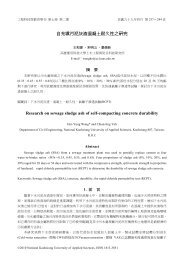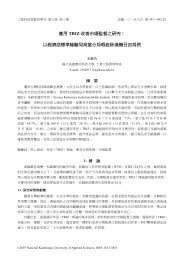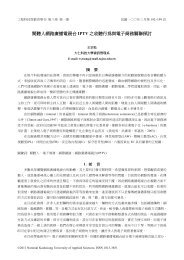Design and Fabrication of Topologically Optimal Miniature ...
Design and Fabrication of Topologically Optimal Miniature ...
Design and Fabrication of Topologically Optimal Miniature ...
Create successful ePaper yourself
Turn your PDF publications into a flip-book with our unique Google optimized e-Paper software.
<strong>Design</strong> <strong>and</strong> <strong>Fabrication</strong> <strong>of</strong> <strong>Topologically</strong> <strong>Optimal</strong> <strong>Miniature</strong> Microgripper Integrated with<br />
an Electro-Thermal Microactuator<br />
177<br />
4. <strong>Fabrication</strong> <strong>and</strong> Experimental Results<br />
The principal parts <strong>of</strong> the microgripper device are: (1) the compliant mechanism <strong>and</strong> (2) the electro-thermal<br />
microactuator. Microgrippers have been successfully fabricated by Photolithography [22] <strong>and</strong> precise<br />
Electr<strong>of</strong>orming [23]. The microgripper is fabricated with an SU-8-thick film photo-resistance, <strong>and</strong> the<br />
microactuator with an all-metal nickel.<br />
The fabrication <strong>of</strong> the compliant mechanism is done by finishing the common sequencing steps in a<br />
photolithography room. These steps involve: wafer cleaning; spin coating <strong>of</strong> the photoresist; s<strong>of</strong>t baking; mask<br />
alignment; exposure; <strong>and</strong> development. First, the silicon wafer was sputtered with an intermediary layer (Al) <strong>and</strong> a<br />
spin coat <strong>of</strong> 200μm thickness, then a SU-8 thick photoresist was put on it. We next used the lithography technique<br />
to obtain the structure <strong>of</strong> the compliant mechanism after removing the intermediary (Al). Figure 13 shows a<br />
scanned electron microscope (SEM) photo <strong>of</strong> the compliant mechanism. The fabrication <strong>of</strong> the electro-thermal<br />
actuator uses the same procedure to develop the electr<strong>of</strong>orming mold.<br />
The nickel is electr<strong>of</strong>ormed up to full <strong>of</strong> mold <strong>and</strong> the SU-8 is removed using the Remover PG from the<br />
MicroChem Company. Figure 14 <strong>and</strong> Figure 15 show an SEM photo <strong>of</strong> the electr<strong>of</strong>orming mold. Figure 16 shows<br />
the model <strong>of</strong> the thermal microactuators. After fabrication, we assembled the microgripper <strong>and</strong> measured the<br />
output displacement <strong>and</strong> performance <strong>of</strong> the microgripper. Figure 17 shows the SEM photo <strong>of</strong> the microgripper.<br />
Figure 18 shows the photograph <strong>of</strong> the measuring instrument, which includes a vibrating isolation table, optical<br />
microscope, X-Y stage, monitor, <strong>and</strong> power supply. In addition, we used a scanning white light interferometry to<br />
obtain the thickness <strong>of</strong> structure.<br />
When an input voltage <strong>of</strong> 1.5V is applied, the gap between microgripper tips is about 18 μm. Figure 19 shows the<br />
output displacement with different applied voltages.<br />
Figure 13.<br />
The SEM photo <strong>of</strong> the compliant mechanism

















